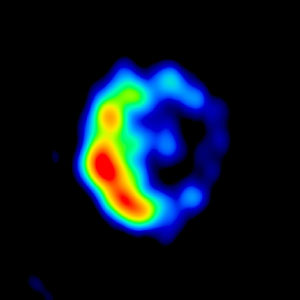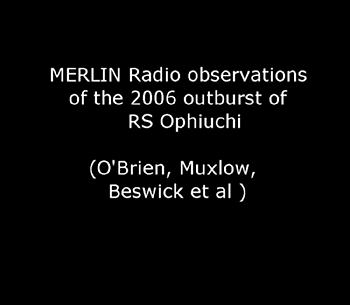Nuclear explosion on dead star - astronomers probe aftermath
19th July 2006
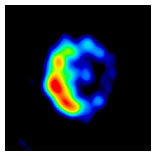
A team of astronomers from the UK and Germany have found that a nuclear explosion on the surface of a star 5,000 light years from Earth resulted in a blast wave moving at over 1,700 km per second (one thousand miles per second or almost four million miles per hour!). The discovery, reported in the 20th July issue of Nature, was made by bringing together many of the world's radio telescopes into arrays capable of seeing the aftermath of the explosion in incredible detail.
During the night of 12th February this year Japanese astronomers reported that a star called RS Ophiuchi had suddenly brightened and become clearly visible in the night sky. Although this was the latest in a series of such outbursts that have been spotted over the last hundred years or so, it was the first since 1985 and therefore an opportunity to bring to bear new, more powerful, telescopes in an effort to understand the causes and consequences of these eruptions.
Dr Tim O’Brien of The University of Manchester’s Jodrell Bank Observatory requested urgent observations with the VLBA (the Very Long Baseline Array of radio telescopes extending from Hawaii to the Caribbean). “Our first observations, made only two weeks after the explosion was reported, showed an expanding blast wave already comparable in size to Saturn’s orbit around the Sun. However, we needed to use the world’s most powerful radio telescopes because, from a distance of 5,000 light years, its apparent size on the sky was only 5 millionths of a degree – the size of a football seen from 2,700 km (1,700 miles) away.”
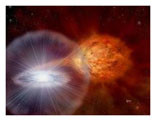
He goes on to explain “The blast wave results from a huge nuclear explosion which takes place on the surface of one of a pair of stars, about 5,000 light years from Earth, which are closely circling one another. Gas captured from one star, a red giant, builds up on the surface of its white dwarf companion (a super-dense dead star about the size of the Earth which was once the core of a star like the Sun whose outer layers have been lost into space).”
Professor Mike Bode of Liverpool John Moores University describes what happens next. “Eventually enough gas collects on the white dwarf for thermonuclear reactions to begin, similar to those which power the Sun but which runaway into a massive explosion. In less than a day, its energy output increases to over 100,000 times that of the Sun, and the gas (about the mass of the Earth) is thrown into space at speeds of several thousand km per second. This ejected matter then slams into the extended atmosphere of the bloated red giant and sets up blast waves that accelerate electrons to almost the speed of light. The electrons release radio waves as they move through a magnetic field that are then picked up by the telescope arrays.”
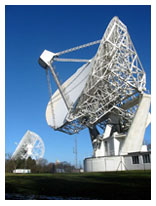
Over the following months, the team continued to track the outburst using the MERLIN array of radio telescopes in the UK, the Very Long Baseline Array (VLBA) and Very Large Array (VLA) in the USA and the European VLBI Network (EVN) which includes telescopes in South Africa and China, a truly global effort. At the same time, they were working with other astronomers across the world using NASA’s Swift satellite to detect X-rays from gas heated to up to 100 million degrees Celsius (nearly 10 times that in the core of the Sun) by the expanding blast wave. The results from the first month of these X-ray observations are described in a separate paper accepted for publication in The Astrophysical Journal.
Dr Richard Porcas of the Max Planck Institute for Radio Astronomy in Bonn coordinated the European VLBI Network observations. “A week after our first observations, we combined telescopes across Europe with two in China and another in South Africa and were surprised to find that the blast wave had become distorted. Over the next few months our observations have shown it turning from a ring into a cigar-like shape. It’s going to need a lot more work to understand exactly what causes this but either the explosion shoots jets of matter in opposite directions or somehow the atmosphere of the red giant is shaping the ejected material.”
Dr Stewart Eyres of the University of Central Lancashire has been monitoring the brightness of the radio source with MERLIN and the VLA. “During this outburst, our first observations with the UK’s MERLIN system were made only four days after the outburst and showed the radio emission to be much brighter than expected. The later behaviour suggests a complex mix of emission from relativistic particles and hot gas in the expanding remnant of the explosion.”
Once the outburst is over, gas will again build up on the white dwarf until at some point, maybe another 20 years in the future, RS Oph should explode again. An important question which the astronomers hope to answer is whether in each explosion the white dwarf throws off all the matter it has collected from the red giant or whether it is hoarding some material and therefore gradually increasing in mass.
Dr Tim O’Brien, who also studied RS Oph’s previous outburst in 1985 for his doctoral thesis, concludes “If the white dwarf is increasing in mass then it will eventually be ripped apart in a titanic supernova explosion and the cycle of outbursts will come to an end.”
Artist's impression of RS Ophiuchi
In this artist's impression of the binary star system RS Ophiuchi hydrogen-rich gas transferred from a red giant onto the surface of a white dwarf has just exploded. Click on the image below for a high-resolution version.
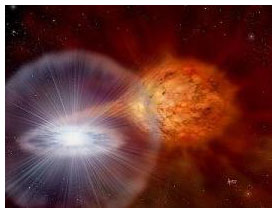
(Credit: David A. Hardy/http://www.astroart.org & PPARC)
Jodrell Bank telescopes
This is a photograph of two of the Jodrell Bank radio telescopes (the 76-metre Lovell Telescope in the background and the 25-metre Mark II telescope in the foreground) whilst observing RS Ophiuchi as part of the European VLBI Network observation on March 5th 2006. Click on the image below for a high-resolution version. Alternative images of the Jodrell Bank telescopes are available at http://www.jb.man.ac.uk/public/gallery.
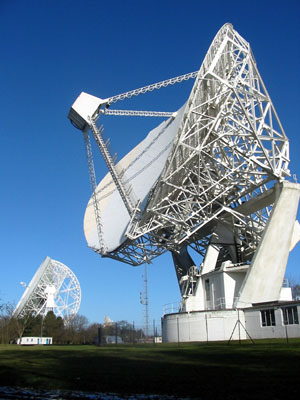
(Credit: Tim O'Brien, Jodrell Bank Observatory)
First radio image of the blast wave
This is the first radio image of the blast wave taken with the VLBA telescope in the USA 14 days after the explosion was reported. The colours relate to radio brightness with blue being faintest and red brightest. The binary star system itself would be at the centre but is invisible in this image. Click on the image below to download a high-resolution version.
Movie of MERLIN radio images
A movie of MERLIN radio images from Feb 18th through May 31st 2006 is available by clicking on the image below (credit: Rob Beswick, Tom Muxlow, Tim O'Brien et al, Jodrell Bank Observatory).
Science Contacts
Dr. Tim O’Brien
Jodrell Bank Observatory, University of Manchester, UK
Tel: +44 (0)1477-571321
E-mail: tob@jb.man.ac.uk
Prof. Michael F. Bode
Astrophysics Research Institute, Liverpool John Moores University, UK
Tel: +44 (0)151-231-2920 (direct) -2919 (secretary)
E-mail: mfb@astro.livjm.ac.uk
Dr. Richard Porcas
Max Planck Institute for Radio Astronomy, Bonn, Germany
Tel: +49 (228) 525 - 0
E-mail: p222rwp@mpifr-bonn.mpg.de
Dr. Stewart Eyres
Centre for Astrophysics, University of Central Lancashire, UK
Tel: +44 (0)1772-893742
E-mail: spseyres@uclan.ac.uk
Press Office Contacts
Julia Maddock
PPARC Press Office
Tel 01793 442094
Email Julia.maddock@pparc.ac.uk
Ian Morison
Jodrell Bank Observatory
University of Manchester, UK
Tel: +44 (0)1477-571321
E-mail: im@jb.man.ac.uk
Background Information
MERLIN (http://www.merlin.ac.uk)
MERLIN is the Multi-Element Radio Linked Interferometer Network, an array of seven radio telescopes distributed around Great Britain, with separations of up to 217km. At a frequency of 5GHz, the resolution of MERLIN is better than 50 milliarcseconds, somewhat greater than that of the Hubble Space Telescope. It is operated by the University of Manchester as a National Facility of the UK Particle Physics and Astronomy Research Council.
VLBA (http://www.vlba.nrao.edu/)
The Very Long Baseline Array (VLBA) is a system of ten radio-telescope antennas, each with a dish 25 meters (82 feet) in diameter and weighing 240 tons. From Mauna Kea on the Big Island of Hawaii to St. Croix in the U.S. Virgin Islands, the VLBA spans more than 5,000 miles, providing astronomers with the sharpest vision of any telescope on Earth or in space. Dedicated in 1993, the VLBA has an ability to see fine detail equivalent to being able to stand in New York and read a newspaper in Los Angeles. The National Radio Astronomy Observatory is a facility of the National Science Foundation, operated under cooperative agreement by Associated Universities, Inc.
EVN (http://www.evlbi.org/)
The European VLBI Network (EVN) is a joint facility of European, Chinese, South African and other radio astronomy institutes funded by their national research councils, conducting unique, high resolution, radio astronomical observations of cosmic radio sources. It is the most sensitive VLBI array in the world, thanks to the collection of extremely large telescopes that contribute to the network.
VLA (http://www.vla.nrao.edu)
The Very Large Array, one of the world's premier astronomical radio observatories, consists of 27 radio antennas in a Y-shaped configuration on the Plains of San Agustin fifty miles west of Socorro, New Mexico, USA. The National Radio Astronomy Observatory is a facility of the National Science Foundation, operated under cooperative agreement by Associated Universities, Inc.
SWIFT (http://www.swift.ac.uk/)
The Swift satellite was designed to study gamma ray bursts. It includes a large field-of-view burst detector, and sensitive X-ray and UV/optical telescopes. The NASA Goddard Space Flight Center manages the Swift project, and the satellite is controlled from Penn State University, using a ground station in Kenya. Swift is a NASA mission with the participation of PPARC and the Italian Space Agency.
PPARC (http://www.pparc.ac.uk)
The Particle Physics and Astronomy Research Council (PPARC) is the UK’s strategic science investment agency. It funds research, education and public understanding in four broad areas of science - particle physics, astronomy, cosmology and space science.
PPARC is government funded and provides research grants and studentships to scientists in British universities, gives researchers access to world-class facilities and funds the UK membership of international bodies such as the European Organisation for Nuclear Research, CERN, the European Space Agency and the European Southern Observatory. It also contributes money for the UK telescopes overseas on La Palma, Hawaii, Australia and in Chile, the UK Astronomy Technology Centre at the Royal Observatory, Edinburgh and the MERLIN/VLBI National Facility.

